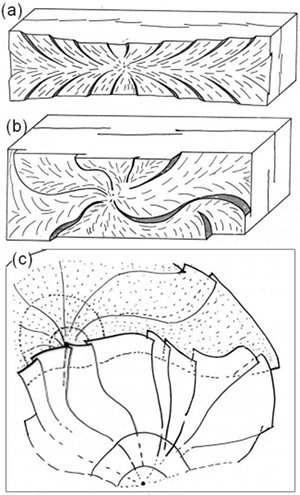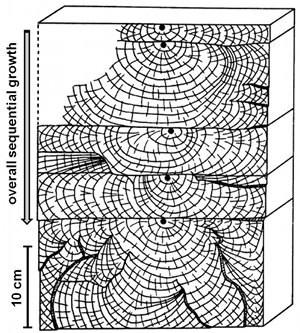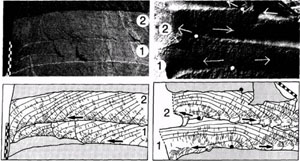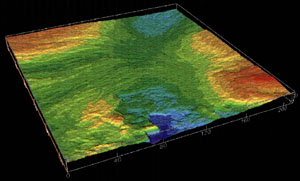| |||||||
|
|
|||||||
|
|
|||||||
| Surface Morphology / Roughness of Joints - Plumose Structure | |||||||
|
Plumose structure (Figures 1 and 2) is common on joint surfaces. It consists of hackle marks that fan away from an axis, curvilinear markers called rib marks, and an initiation point (origin). Away from the origin, there are often mirror, mist, and hackle zones. Sometimes hackle marks grow larger and rotate visibly at the border of joints. Because of their location with respect to the rest of the joint plane, they are called fringe joints. Plumose structures can be used to determine the initiation points even when the actual initiation points are not visible. Hackle marks converge to the initiation points. Stress distribution in a layer may give rise to either symmetric (Figure 2a) or asymmetric (Figures 2b and c) plumose patterns. In layered rocks, a joint, once initiated, propagates mostly laterally because layer thickness is smaller than other dimensions of layers. The vertical growth of joints generally occurs by propagation of joints from one layer (either depositional or mechanical) to the next (Figure 3 and Figure 4). The implication of these patterns for incremental joint growth is that the initiation points are located at the leading front of the trailing segments and the terminations are marked by fringe joints.
The roughness of joint surface can be visualized by various techniques. Figure 5 shows an example using Wood's metal injection test using two symmetric natural fracture surfaces of a granitic sample subjected to a normal stress of 33 MPA. Figure 6 shows a laser profilometer image of a joint surface topography in siltstone. The figures illustrate the inherent variation of the spatial distribution of natural fracture topography and divergence from ideal planar geometry. Images of the opposing joint surfaces can be used to calculate joint aperture and visualize formation of open channels when the opposing joint surfaces move relative to each other. The development of the concept of fractal geometry in the 1970s has revealed that the shape and pattern of all types of natural fractures carry valuable information. Brown and Scholz (1985) analyzed the roughness of natural rock fracture surfaces over a broad band of spatial frequencies and found fractal dimension varied with frequency. From this study, they concluded that rock surface roughness was not self-similar on all scales and no simple scaling laws exist. Brown (1987) suggested that the scaling properties of rock fractures depended not only on their fractal dimensions but also on the minimum horizontal resolution at which the profile must be measured in order to produce a valid estimation of fractal dimension. | |||||||
| Types of Surface Morphology / Roughness of Joints - Plumose Structure: | |||||||
| OriginHackle MarksRib MarksMirror and Mist | |||||||
| Reference: |
|||||||
| Aydin, A., Borja, R., Eichhubl, P., 2006 Brown, S.R., Scholz, C.H., 1985 Brown, S.R., 1987 DeGraff, J.M., Aydin, A., 1987 Helgeson, D., Aydin, A., 1991 Pollard, D.D., Aydin, A., 1988 Pyrak-Nolte, L.J., Myer, L.R., Nolte, D.D., 1992 |
|||||||
|
Readme | About Us | Acknowledgement | How to Cite | Terms of Use | Ⓒ Rock Fracture Knowledgebase |
|||||||





